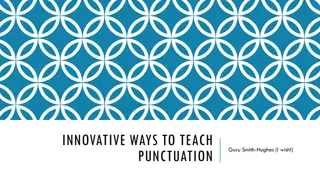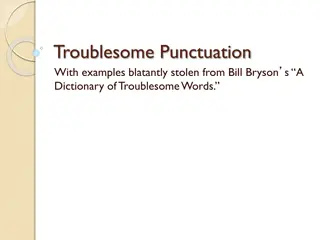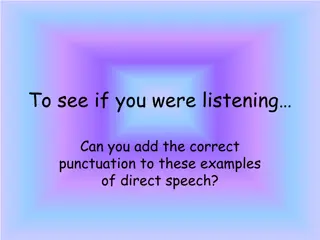Mastering Punctuation Rules and Usage
Learn about common punctuation problems such as apostrophes, titles capitalization, colons, and semicolons. Understand the correct usage of apostrophes for possessives and contractions, capitalize titles properly, use colons to introduce ideas or lists, and employ semicolons to separate items effectively. Enhance your writing by mastering these fundamental punctuation rules.
Uploaded on Sep 17, 2024 | 0 Views
Download Presentation

Please find below an Image/Link to download the presentation.
The content on the website is provided AS IS for your information and personal use only. It may not be sold, licensed, or shared on other websites without obtaining consent from the author. Download presentation by click this link. If you encounter any issues during the download, it is possible that the publisher has removed the file from their server.
E N D
Presentation Transcript
Top Ten #8 Punctuation problems
APOSTROPHES The 2 main uses (which is not A s, 3 s, and $ s) : To make possessives/show ownership (covered in prior rule #9) To make contractions, as noted below: Contractions: use the apostrophe in place of omitted letters or numbers Do + not = don t Should + have = should ve Class of 2017 = 17 Going = goin ***Do not confuse contractions with possessive pronouns its vs. it s your vs. you re their vs. they re
TITLES capitalization, quotation marks, underlining, italics ***Use quotation marks when writing song titles, poem titles, short story titles, names of tv episodes, chapters of a book, and articles (whether magazine/encyclopedia/internet). Many also include essays as well. You do this because they are part of a larger whole. MLA calls it the container. ***The larger whole gets underlined if handwriting or italics if your text is computer generated. It s never both!
COLON ***Use a colon to introduce an idea or a list with these requirements in your formal written work 1. the colon must follow a complete sentence 2. it cannot follow a verb 3. it cannot come in the middle of a phrase (like such as or for example) No: I think the best colors are: blue, red, and pink. They are the colors of: my car, my bedroom, and my favorite shirt. Yes: Rita wants the following for her birthday: a pony, a cake, and a doll.
COLON DAILY DOUBLE Two ideas for the price of one!
Youve previously learned three ways to write the following ICs: Ex. Barney made BJ a birthday cake. Barney made BJ a birthday cake, and Babybop made him a card. Barney made BJ a birthday cake; Babybop made him a card. Babybop made him a card. In #10, we suggested to use an adverbial conjunction after a semicolon as a transition that show sequence, comparison, contrast, etc. Ex. He loves chocolate; however, he likes vanilla much more. He failed the test; therefore, he will take a 2ndchance. But there is another way!
COLONS ***Use a colon between two independent clauses if (and only if) the second explains or summarizes the first. Ex. Garlic is used in many recipes: it enhances the flavor of starches.
SEMICOLON What would this sentence say literally: I brought my tent, my birthday present, a sleeping bag, S mores, my favorite snack, and clothes on my camping trip. Thus, use a semicolon to separate items when one or more of the units contains a comma which would cause confusion. This rule usually pertains to lists or phrases/clauses. I brought my tent, my birthday present; a sleeping bag; S mores, my favorite snack; and clothes on my camping trip.
HYPHENS and DASHES Oddly When typing, a dash is two hyphens typed without spaces before, after, or between them. However, most modern programs change the -- to automatically. In handwritten work make sure you distinguish it from the hyphen by making it longer!
DASHES Dashes can be used (in informal work MLA doesn t like dashes) to show clarification, interruption, or change of thought -like commas or parenthesis. I went --by myself-- to the movies.
HYPHENS Hyphens are generally used to join words. Some of the most common hyphen rules are as follows: Compound adjectives when they are a single idea and come before the noun EX. A one-way street; chocolate-covered cherries; well-known artist To spell out compound numbers between 21 and 99 and fractions Words that may have an odd combo of letters Ex. Semi-independent; shell-like There are many, many, many more rules, especially with compound nouns, verbs, and phrases. The best strategy is to use a dictionary!























